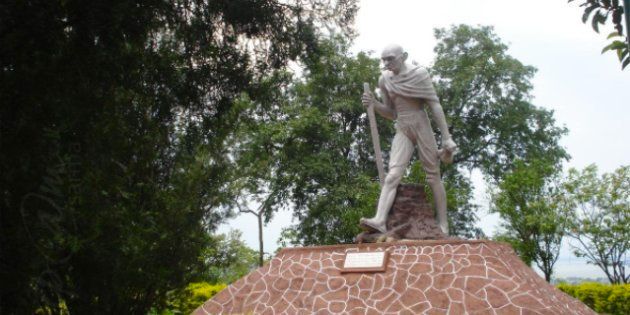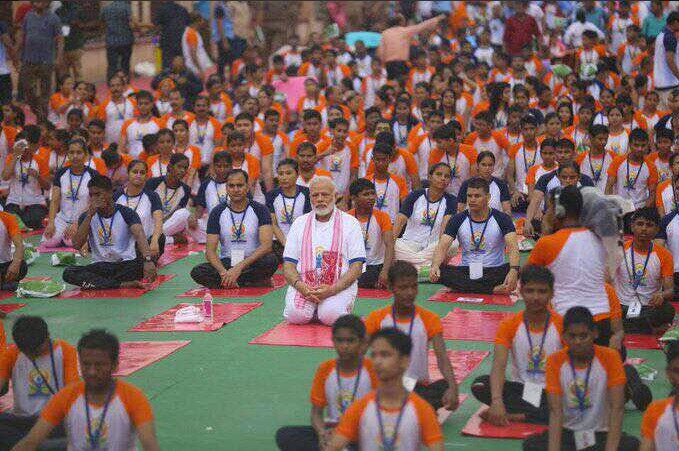
The BJP-led government in Assam plans to remove a statue of Mahatma Gandhi, created by Ramkinkar Baij, one of the masters of modern Indian art, and stationed in Guwahati nearly fifty years ago, The Indian Express reported this morning.
The sculpture, cast in concrete, was unveiled on 2 October, 1970, by then Chief Minister Bishnu Ram Medhi. It seems to have survived the elements for so many decades perhaps because the public works department (PWD), run by successive political regimes, did whatever it could towards keeping it erect. Instead of sound techniques of art restoration, the statue got a coat of whitewash, later replaced by plastic paint, on a few special days of the annual calendar. But one mustn't complain.
Most specimens of public art in India don't even get a cursory scrub for months on end. Birds and beasts end up using these structures to nest, rest or defecate. The Father of the Nation appears to have been lucky to have been treated with such kindness over the years.
The present dispensation, however, is miffed not with Gandhi per se, although its feelings towards him are far from unambiguous, but rather, with the maker of his "likeness". The trouble, in fact, is with the term itself — or rather, with its conspicuous absence. For the authorities are of the mind that the statue, which had stood for a good half a century, "distorts" its subject. There is little resemblance whatsoever between the way Baij chose to depict Gandhi and his real-life persona. (Is anyone surprised that the statue doesn't look anything like Gandhi, given the annual government ritual of painting it with substances not meant for it?)
The problem with this line of argument is that it's at once true and incredibly daft. Sadder still, it goes on to reveal an appalling ignorance of the first principles of making art, especially for public display. The purpose of portraiture, be it in painting or sculpture, is not necessarily to make an exact replica of the subject, though that, too, has its place in the world. When an artist is commissioned to create an image or a statue of a public figure, there is an implicit expectation that the final outcome would reveal something rich and strange about the subject of the work, a special character that may have escaped public scrutiny.
The genius of an artist like Baij lies not only in his artistry but rather in his gift to manifest before viewers an aspect of the subject that isn't obvious from existing evidences of their life. An exact likeness of Gandhi may be sourced from any number of photographs of him or be produced by a competent student of the fine arts with some serviceable skill at imitation. But only someone with the penetrating gaze of Baij would be able to look beyond the film of familiarity and get to the essence of Gandhi, the mass leader. In the statue in Guwahati, Baij left his trademark impressions as a sculptor, although it is believed that the work, which he began in 1968, was completed by his assistants. He also made other statues of the Mahatma, especially one showing him on the Dandi March. Since it's even more stylised than the one in Guwahati, one wonders what our current arbiters of public taste would make of it, should they ever come across it.
Born into a family of modest means in 1906, Baij had a talent for drawing and painting, which led him to enrol at the art school in Santiniketan, established by Rabindranath Tagore. There, he was fortunate to be mentored by the legendary teacher and artist, Nandalal Bose, who initiated Baij into the great intellectual movements, in both politics and the arts across the world, in the 1920s.
Exposed to both European modernism and the masters of the Bengal School of Art, Baij created a style unique to his sensibility, nurtured by the customs of tribal life he noted in the state of his birth Bankura and later in Birbhum, where he spent most of his adult life.
In 1938, he made the iconic sculpture of the Santhal Family, depicting the plight of one of the poorest communities in India. In spite of its premise in figuration, the work has strong affinities with abstract art, the sharp angularity of European masters like Giacometti, for instance. Standing tall till this day, timeless in its resonances, it conveys the struggle for subsistence as well as the burden of circumstances that plague the lives of the Adivasis of the region.
Over the years, many more of Baij's sculptures dotted the campus of the Visva-Bharati University in Santiniketan. Some also travelled beyond, to Kolkata, to New Delhi (the famous yaksha and yakshini outside the RBI Building in the national capital, for instance) and even abroad.
Perhaps not oddly, long before the controversy over Gandhi erupted, Baij was at the centre of another storm involving a bust of Tagore made by him that was installed in Hungary in 1984. Once again, it was criticised for not being a faithful reproduction, being based on Tagore's last years when his failing health had affected his appearance. At that time, several public intellectuals, including Satyajit Ray, intervened in Baij's support and the matter was resolved without much ado. However, given the political climate of our time, the fiasco over the Gandhi statue, for which a replacement is believed to have been ordered, is unlikely to end as harmoniously.
The public may be unaware of the nuanced purposes behind public art, so it is the task of the custodians of public space to communicate these sentiments to it. But that, alas, is possible only if the stakeholders are themselves informed about such higher principles or if they care to find out the legacy of the creators who were responsible, in the first place, for those public art that so offend their sensibilities.
Also on HuffPost
BJP
